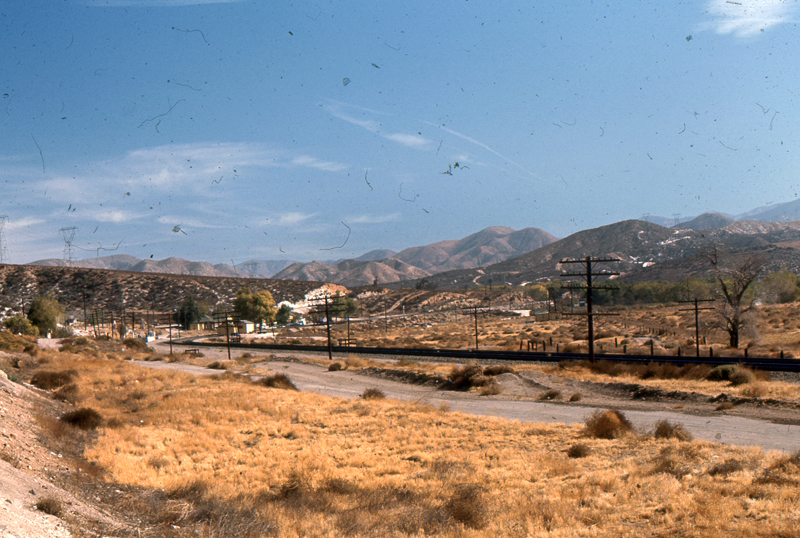View of the onetime Southern Pacific whistle stop of Ravenna on Soledad Canyon Road.
One in a grouping of color slides shot in Soledad Canyon from 1967-70.
It is unlikely that any more than a few dozen people ever lived in the little mining town of Ravenna at any
one time, but the town nonetheless sported a full train station. It was located four miles southwest of Acton in Soledad
Canyon.
A number of miners, most notably Colonel Thomas Finley Mitchell, arrived in Soledad Canyon in 1860 and
set up various mining camps near the canyon's rich veins of gold, silver and copper, which came into great demand
when the Civil War broke out only a year later. Local historian Jerry Reynolds writes (in "Santa Clarita: Valley of the Golden Dream"):
"A conglomeration of log cabins and tents moved up and down the canyon with each new strike.
Called 'Soledad City' wherever it was plunked down, it provided such basic needs as faro
tables, rye whiskey, and ladies of the evening. A portable grocery was operated by James O'Reilly,
a flaming-haired Irishman of medium build, pug nose, and happy-go-lucky air about him."
It wasn't long before a post office was needed, and as one might expect, the U.S. Postal Service rejected the name
"Soledad City" out of fear that it would be confused with the city of Soledad in Monterey County. O'Reilly
suggested the name "Ravenna," in honor of the local merchant and saloon keeper, Manuel Ravenna.
The name became official June 12, 1868.
Ravenna became a shipping point from which gold, silver, copper and other minerals were hauled off to the port at San Pedro.
Freight wagons drawn by oxen or mules were used at first; they gave way to rail cars after the first steam locomotives
chugged through the canyon in 1876. In 1885 a paper mill was set up to pulp Joshua trees from the Antelope Valley, but
it fell out of use by 1889 because the paper was of poor quality.
Besides precious and semi-precious metals, the area was also rich in a variety of gemstones, particularly moss agate and green waxy quartz, which were hunted in the 1950s.
While strip mining is still a big industry in the Soledad and in parts of the
neighboring Mojave Desert, the little mining camp of Ravenna — and its rather sizable train station —
are nothing more than faded memories.
About the photographer:
James Krause was a 20-year-old art and history student at San Fernando Valley State College (now CSUN) when, in February 1967, his family moved to 19549 Fairweather St. in Saugus — later called Canyon Country. After graduating in 1968 and aspiring to become a teacher, James worked at the Flare-Northern division of the Atlantic Research Corporation in Saugus, a defense subcontractor that manufactured explosive devices for Sandia National Laboratories in Albuquerque, New Mexico. Flare-Northern was located at 19701 W. Goodvale Road, in the hills west of the Krause home.
Lucky for us, James enjoyed touring the canyons and shot numerous photographs from 1967-1970, focusing particularly on Soledad Canyon from present-day Canyon Country
to Acton, and on its Southern Pacific Railroad features. He shot many of the photos in November 1970 while on leave from Vietnam. His teaching pursuits had been derailed; he entered the Army on Nov. 5, 1968, and went through basic and infantry training at Ford Ord, Calif., followed by NCO training at Ft. Bening, Geo. In October 1969 he served as a staff sergeant with the 101st Airborne Division in the northernmost part of South Vietnam, operating from the DMZ to an area near the Laotian border. In November 1970 he transfered to the 14th Armored Cavalry (later the 11th Armored Cavalry) in West Germany, patrolling the border with East Germany until his discharge in March 1973. By that time, the earthquake of Feb. 9, 1971, had hit the Santa Clarita Valley and his family moved away from Saugus.
James' early interest in railroads was no passing fancy. Following his military service he joined the Union Pacific Railroad, first as a maintenance-of-way foreman for about a year and then as a locomotive engineer, a position he held until his retirement Aug. 29, 2011 (except for brief try at the restaurant business from 1992 to 1995). He drove trains in California, then Missouri and finally in Texas, where he lives as of 2012. He had three children with his first wife who, like James, was a Union Pacific Railroad engineer in Southern California. According to James, the UP believes they may have been the first husband-and-wife locomotive engineers in the United States.
JK0071: 9600 dpi jpeg from color transparency (slide) | Digital image only | Archival scan on file








